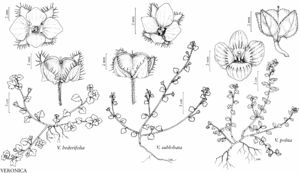Difference between revisions of "Veronica polita"
Novit. Fl. Svec., 63. 1819.
FNA>Volume Importer |
imported>Volume Importer |
||
| (5 intermediate revisions by 2 users not shown) | |||
| Line 13: | Line 13: | ||
}}{{Treatment/ID/Special_status | }}{{Treatment/ID/Special_status | ||
|code=F | |code=F | ||
| − | |label= | + | |label=Illustrated |
}} | }} | ||
|basionyms= | |basionyms= | ||
| Line 31: | Line 31: | ||
|elevation=0–600 m. | |elevation=0–600 m. | ||
|distribution=Man.;N.B.;Ont.;Ala.;Ariz.;Ark.;Colo.;Conn.;D.C.;Fla.;Ill.;Ind.;Iowa;Kans.;Ky.;La.;Maine;Md.;Mass.;Mich.;Mo.;Nebr.;N.Y.;N.C.;Ohio;Okla.;Pa.;Tenn.;Tex.;Va.;W.Va.;Wis.;Eurasia;nw Africa (Algeria;Morocco);introduced also in Mexico;s South America. | |distribution=Man.;N.B.;Ont.;Ala.;Ariz.;Ark.;Colo.;Conn.;D.C.;Fla.;Ill.;Ind.;Iowa;Kans.;Ky.;La.;Maine;Md.;Mass.;Mich.;Mo.;Nebr.;N.Y.;N.C.;Ohio;Okla.;Pa.;Tenn.;Tex.;Va.;W.Va.;Wis.;Eurasia;nw Africa (Algeria;Morocco);introduced also in Mexico;s South America. | ||
| + | |introduced=true | ||
|discussion=<p>Plants of <i>Veronica polita</i> are similar to those of the more frequent <i>V. persica</i> and are probably frequently overlooked.</p> | |discussion=<p>Plants of <i>Veronica polita</i> are similar to those of the more frequent <i>V. persica</i> and are probably frequently overlooked.</p> | ||
|tables= | |tables= | ||
| Line 40: | Line 41: | ||
-->{{#Taxon: | -->{{#Taxon: | ||
name=Veronica polita | name=Veronica polita | ||
| − | |||
|authority=Fries | |authority=Fries | ||
|rank=species | |rank=species | ||
| Line 55: | Line 55: | ||
|publication title=Novit. Fl. Svec., | |publication title=Novit. Fl. Svec., | ||
|publication year=1819 | |publication year=1819 | ||
| − | |special status=Introduced; | + | |special status=Introduced;Illustrated |
| − | |source xml=https:// | + | |source xml=https://bitbucket.org/aafc-mbb/fna-data-curation/src/2e0870ddd59836b60bcf96646a41e87ea5a5943a/coarse_grained_fna_xml/V17/V17_771.xml |
|genus=Veronica | |genus=Veronica | ||
|species=Veronica polita | |species=Veronica polita | ||
Latest revision as of 19:36, 5 November 2020
Annuals. Stems creeping to decumbent, 5–20(–40) cm, eglandular-hairy. Leaves: blade suborbiculate to ovate, rarely oblong-ovate, (3–)6–11(–14) × (3–)4–9(–10) mm, base truncate, margins serrate to dentate, teeth 2–4 per side, apices usually rounded, apex acute to obtuse, abaxial surface densely hairy, adaxial sparsely hairy to glabrate. Racemes 1–4, terminal, 50–200(–400) mm, 5–20-flowered, axis sparsely to densely hairy or glabrate; bracts suborbiculate to ovate, (3–)6–11(–14) mm. Pedicels usually semicircularly recurved, (3–)6–13(–15) mm, 0.5–1.5 times subtending bract, densely eglandular-hairy. Flowers: calyx lobes broadly ovate, (3–)4–6(–7) mm, 2.6–3.8 mm wide, apex acute, eglandular-hairy, rarely glandular-hairy; corolla intense dark to bright blue, rarely pale lilac or white, with darker nerves, abaxial 1/2 often brighter to whitish, (3–)4–7(–8) mm diam.; stamens 0.5 mm; style (0.5–)1–1.6(–1.8) mm. Capsules ± round in cross section, obcordiform, (2.5–)3–4(–4.5) × (3.5–)4–6(–6.3) mm, apex emarginate, sinus angle 20–60(–80)°, densely eglandular-hairy, sometimes also glandular-puberulent, rarely glabrous. Seeds (7–)16–24(–30), pale yellow, ellipsoid to ovoid, deeply cymbiform, 0.9–1.6 × (0.5–)0.8–1.3 mm, 0.4–0.8 mm thick, rugose-cristate. 2n = 14 (Eurasia).
Phenology: Flowering (Feb–)Mar–Jun(–Jul).
Habitat: Fields, ruderal places, calcareous soils, lawns.
Elevation: 0–600 m.
Distribution
Introduced; Man., N.B., Ont., Ala., Ariz., Ark., Colo., Conn., D.C., Fla., Ill., Ind., Iowa, Kans., Ky., La., Maine, Md., Mass., Mich., Mo., Nebr., N.Y., N.C., Ohio, Okla., Pa., Tenn., Tex., Va., W.Va., Wis., Eurasia, nw Africa (Algeria, Morocco), introduced also in Mexico, s South America.
Discussion
Plants of Veronica polita are similar to those of the more frequent V. persica and are probably frequently overlooked.
Selected References
None.
